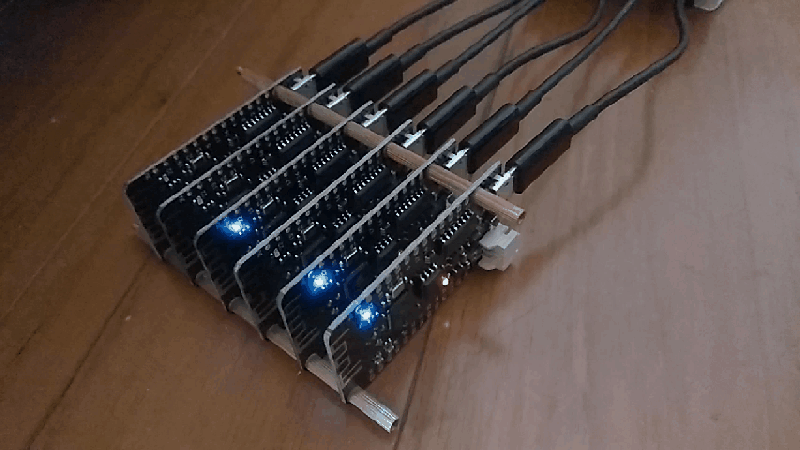If the computer you have isn’t particularly fast, there’s a well-documented way to get more out of it. You just need more of the same computer, and you can run your tasks on them all at the same time. Building computer clusters is an effective way of decreasing the time it takes for computers to solve certain problems, even if the computers themselves aren’t top-of-the-line hardware. Of course, with cheap enough hardware, people will build clusters out of just about anything, including the ESP32.
For this project, [Wei Lin] admits that this isn’t really a serious attempt at building speedy hardware, but rather an interesting exercise in creating a cluster as a sort of learning experience. ESP32 boards can be found for around $10 so building an experimental cluster with these is even more feasible than using the Raspberry Pi. [Wei Lin] goes into a great amount of detail on his GitHub page about all of his goals with the project, most of which involve exploring the functionality of the new cluster and its underpinnings.
While this might seem like little more than a thought experiment, it does have the advantage of being a great solution for problems that involve gathering data from points that are physically very far from one another. If you’ve ever been interested in parallel computing or computing clusters, this is a great project to check out. If you have more Raspberry Pis on hand than ESP32s and still want to build a cluster, check out this project that used a mere 750 of them for one.
















Mmmm blinky lights
The trouble is network. Please create network between esp (similar meridian)
each with other and this supercomputer will be more usefull.
Sorry but small epiphany parallela with 16 cores and cost 99$ is better, with normal linux, and soon will be create 1024 cores processor.
You will not see a 1024 core Epiphany.
The chip taped out, but the founder has left the company for a job in DARPA.
The company only supports the existing customers and keeps selling the remaining stock.
http://www.adapteva.com/andreas-blog/adapteva-status/
He sold out to the military – wow bad karma
I woul like to have one FPGA to glue this processors
So what can it actually do other than the blinkies?
Educate. Nothing more, nothing less.
Nothing more needed.
Professional hater, hard at work.
It solves the problem of students having too much CPU speed available to ever find a problem bad enough to have to resort to running multiple CPUs in parallel. The CPU speed is not even close to a 3.6GHz Core i7, so the students will have to resort to all the tricks that they learned, to get any performance for their parallel tasks. It’s up to the teacher to define the task that needs parallel processing on multiple CPUS. :)
Reminds me of an ECU design where the designers calved 5 MIPs off of a 20 MIPs micro-controller for input signalling conditioning on one input to save them the complex one time hassle of doing the math for t=RC and using a 1cent capacitor and a 1 cent resistor to do the signal conditioning.
Fix it in software ^(n)
While supercomputers are usually cluster machines nowday’s making a cluster does not mean its a supercomputer
“ESP32 boards can be found for around $10 so building an experimental cluster with these is even more feasible than using the Raspberry Pi.”
Considering the Raspberry Pi Zero costs less than $10 and is more powerful than the ESP32, I don’t really see the point.
Soooo, where can you buy a handful of Pi Zeroes at any one time/place?
I bought a bunch of “Orange Pi Zero H2 Quad Core” but think i only payed 6$/piece
http://s.aliexpress.com/uu6z2iu2
Exactly what I wanted to write. An Orange Pi will beat this cluster for fraction of the price.
Micro Center.
My closest (90 minutes away) Micro Center has a limit of 3, which is debatable as a “handful”.
Microcenter. I was successful with my attempt at getting two Raspberry Pi Zeros at the same time by bringing my dad. I don’t know how far it can scale, but I honestly believe that I could get six from a single trip by bringing enough people. Obviously not an option for many, but still a possibility. In reality, I just want to see how far I can go with
I just got an esp32 dev board for $4 on ebay. think they’re trying to boost their seller rating or something. I was really expecting to get an esp8266 for that price or I would’ve gotten more. (I’ve ordered a couple suspiciously cheap esp32s before and gotten esp8266s and bitched for full refunds)
Ooh, thanks for the reminder I have to request a refund for my own suspiciously cheap “esp32s”
But don’t you see, (ESP)82 is greater than (ESP)32, therefore it must be more powerful.
They were giving you a bargain!
B^)